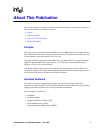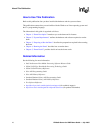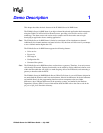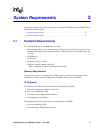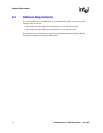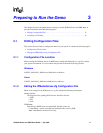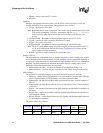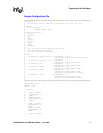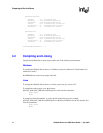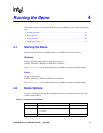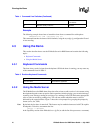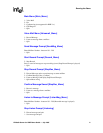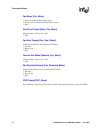
16 IP Media Server for HMP Demo Guide — July 2005
Preparing to Run the Demo
• InBand – usually used with G.711 coders
• RFC2833
Capability
Describes the transmit and receive coders. See the Global Call IP Technology Guide for
specific information about coder support. The parameters are as follows:
• TxType – the transmit voice coder
Note: By default, the fax demo is turned off. This feature may be enabled when tested with
T.38 capable IP endpoints. To do this, “uncomment” the line
TxType = t38UDPFax
in this section by removing the # from the start of the line, or add the line if not
present.
• TxFramesPerPkt – the number of frames per packet for the selected Tx coder
• TxVAD – specifies if VAD is active for the selected Tx coder
• RxType – the receive voice coder
• RxFramesPerPkt – the number of frames per packet for the selected Rx coder
Note: The G.711 coder defines frames per packet using the packet size in milliseconds, i.e.
10, 20, or 30 milliseconds. Refer to the Sample Configuration File, below, for the
correct syntax for all the parameters.
• RxVAD – specifies if VAD is active for the selected Rx coder
Quality of Service
The application can set threshold values to monitor the quality of service during calls. A fault
occurs when the result of a measurement of a QoS parameter crosses a predefined threshold. A
success occurs when the result of a measurement of a QoS parameter dis not cross a predefined
threshold. The QoS parameters are measured during time intervals, starting when a call is
established. The following parameters are supported:
• MediaAlarmLostPackets – monitors the number of lost IP packets during a call
• MediaAlarmJitter – monitors the jitter (as defined in RFC 1889) during IP transmission
QoS Attributes
The threshold for each QoS parameter is measured with the following six attributes:
• Threshold – defines when a QoS parameter is in a fault condition. A fault occurs when the
result of a measurement of a QoS parameter crossed the Threshold value.
• DebounceOn – the time during which faults are measured (in msec., must be multiple of
Interval)
• DebounceOff – the time during which successes are measured (in msec., must be multiple
of Interval)
• Interval – the amount of time between two QoS parameter measurements (in multiples of
100 msec)
• Percent_Fail – used to detect failure condition, together with DebounceOn (expressed as
a percentage of failures)
• Percent_Success – used to detect failure recovery, together with DebounceOff (expressed
as a percentage of successes)
The default values are as follows:
QoS Type Threshold DebounceOn DebounceOff Interval
Percent_
Fail
Percent_
Success
Lost packets 20 10000 10000 1000 60 40
Jitter 60 20000 60000 5000 60 40




